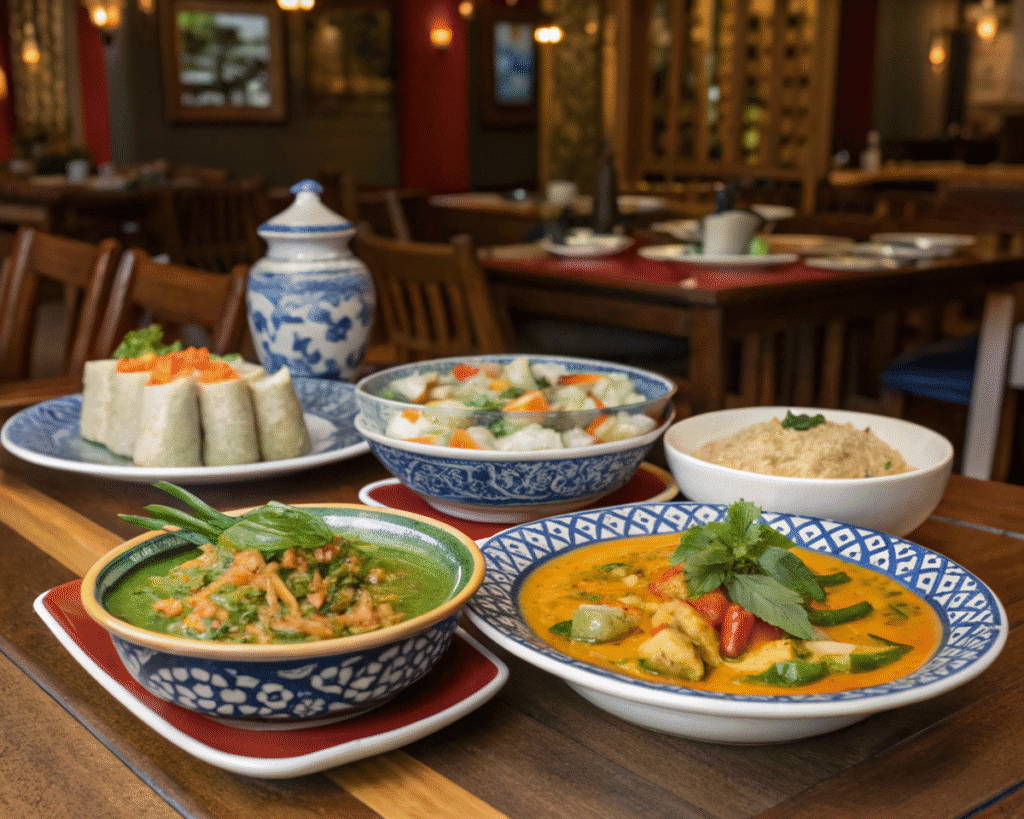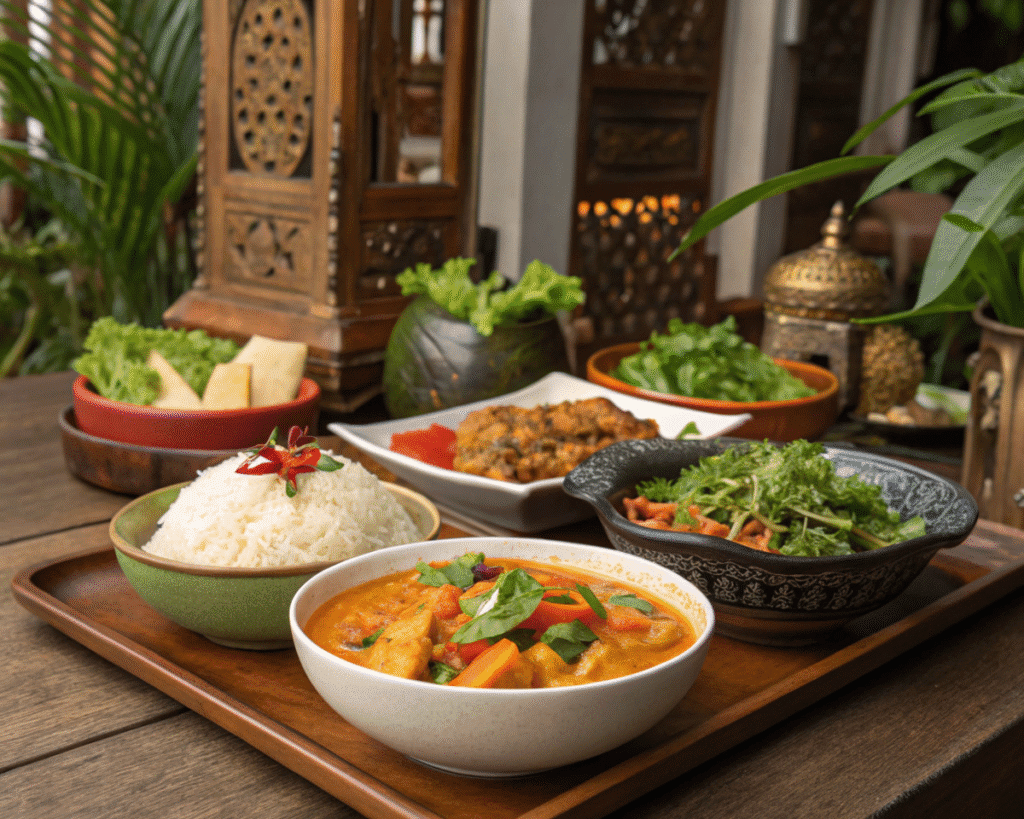
Thai cuisine halal blends the vibrant, spicy, and aromatic flavors of traditional Thai food with the dietary principles of Islamic law. This unique fusion caters to Muslim food lovers who crave Thailand’s iconic dishes while adhering to halal standards. From fiery curries to fragrant stir-fries, Thai cuisine halal offers a delightful culinary experience that respects religious guidelines. In this article, we explore the origins, preparation methods, nutritional benefits, and key aspects of Thai cuisine halal, ensuring you have all the information to savor this exquisite fusion.
What Is Thai Cuisine Halal?
Thai cuisine halal refers to Thai dishes prepared in accordance with Islamic dietary laws, which prohibit pork, alcohol, and non-halal meat (animals not slaughtered according to Islamic guidelines). Chefs adapt traditional Thai recipes by using halal-certified ingredients, such as chicken, beef, seafood, or plant-based proteins, while preserving the bold flavors that define Thai food—sweet, sour, salty, spicy, and umami. Popular dishes like green curry, tom yum, and pad Thai can all be made halal without compromising authenticity.
This culinary style appeals to Muslim communities worldwide, particularly in regions with significant Muslim populations, such as Malaysia, Indonesia, and the Middle East. It also attracts food enthusiasts seeking diverse, flavorful meals that align with their dietary restrictions.
Origins of Thai Cuisine Halal
Thai cuisine halal traces its roots to Thailand’s diverse cultural landscape. Thailand, known for its rich culinary heritage, has a significant Muslim population, particularly in the southern provinces like Pattani, Yala, and Narathiwat. These regions, influenced by Malay culture, have long integrated Islamic dietary practices into Thai cooking. Over time, halal versions of Thai dishes emerged, blending local ingredients like lemongrass, galangal, and chili with halal-compliant proteins.
The global rise of halal food markets has further popularized Thai cuisine halal. As Muslim travelers and diaspora communities seek halal options abroad, restaurants in Thailand and beyond have adapted menus to cater to this demand. Cities like Bangkok and Chiang Mai now boast halal-certified eateries serving authentic Thai flavors, making Thai cuisine halal a global phenomenon.
Key Ingredients in Thai Cuisine Halal
Thai cuisine halal relies on fresh, aromatic ingredients to create its signature flavors. Here are the staples that define this culinary style:
- Halal Proteins: Chicken, beef, lamb, and seafood (like shrimp or fish) replace pork, ensuring compliance with Islamic law. Tofu and tempeh serve as plant-based alternatives.
- Herbs and Spices: Lemongrass, galangal, kaffir lime leaves, Thai basil, and cilantro add freshness and aroma. Chilies provide the heat that Thai food is famous for.
- Coconut Milk: A creamy base for curries and soups, coconut milk balances spice and adds richness.
- Fish Sauce Alternatives: Traditional Thai fish sauce, which may contain non-halal ingredients, is replaced with halal-certified versions or soy-based alternatives.
- Rice and Noodles: Jasmine rice, sticky rice, or rice noodles form the foundation of many dishes, offering versatility and texture.
- Tamarind and Lime: These ingredients deliver the tangy, sour notes essential to Thai flavor profiles.
By sourcing halal-certified ingredients, chefs maintain the authenticity of Thai cuisine while adhering to religious guidelines.
How to Make Thai Cuisine Halal at Home
Preparing Thai cuisine halal at home is easier than you might think. With the right ingredients and techniques, you can recreate restaurant-quality dishes. Below are two popular halal Thai recipes to get you started.
Halal Thai Green Curry (Gaeng Keow Wan)
This creamy, spicy curry is a Thai classic that’s simple to make halal.
Ingredients (Serves 4):
- 500g halal chicken breast, thinly sliced
- 400ml coconut milk
- 2 tbsp halal green curry paste
- 1 cup bamboo shoots
- 1 red bell pepper, sliced
- 1 small eggplant, cubed
- 2 tbsp halal fish sauce or soy sauce
- 1 tbsp palm sugar
- 4 kaffir lime leaves
- 1 cup Thai basil leaves
- 2 red chilies, sliced (optional)
- 1 tbsp vegetable oil

Instructions:
- Heat oil in a large pan over medium heat. Add green curry paste and stir-fry for 1-2 minutes until fragrant.
- Pour in half the coconut milk and stir until the paste dissolves.
- Add chicken slices and cook for 5 minutes until partially cooked.
- Stir in the remaining coconut milk, bamboo shoots, eggplant, and bell pepper. Simmer for 10 minutes.
- Add halal fish sauce, palm sugar, and kaffir lime leaves. Stir well.
- Toss in Thai basil leaves and red chilies. Simmer for 2 more minutes.
- Serve hot with jasmine rice.
Halal Tom Yum Goong (Spicy Shrimp Soup)
This tangy, spicy soup is a staple in Thai cuisine and easily adaptable for halal diets.
Ingredients (Serves 4):
- 400g shrimp, peeled and deveined (halal-certified)
- 4 cups water or halal chicken broth
- 2 stalks lemongrass, bruised and cut into 2-inch pieces
- 3 slices galangal
- 3 kaffir lime leaves
- 2 tbsp halal fish sauce or soy sauce
- 1 tbsp chili paste (nam prik pao)
- 1 cup mushrooms, sliced
- 2 tomatoes, quartered
- 2 red chilies, sliced
- Juice of 1 lime
- Fresh cilantro for garnish
Instructions:
- Bring water or broth to a boil in a pot. Add lemongrass, galangal, and kaffir lime leaves. Simmer for 5 minutes.
- Add shrimp and mushrooms. Cook for 3-4 minutes until shrimp turn pink.
- Stir in chili paste, halal fish sauce, and tomatoes. Simmer for 2 minutes.
- Remove from heat and add lime juice and red chilies.
- Garnish with cilantro and serve hot.
Tips for Cooking Thai Cuisine Halal
- Source Halal Ingredients: Check for halal certification on meat, fish sauce, and curry pastes to ensure compliance.
- Balance Flavors: Thai cuisine thrives on a balance of sweet, sour, salty, and spicy. Taste and adjust seasonings as you cook.
- Use Fresh Herbs: Fresh lemongrass, Thai basil, and kaffir lime leaves elevate authenticity and flavor.
- Control Spice Levels: Adjust the number of chilies to suit your taste, as Thai cuisine can be fiery.
- Invest in a Wok: A wok helps achieve the high heat needed for stir-fries and curries.
Nutritional Benefits of Thai Cuisine Halal
Thai cuisine halal offers a range of health benefits, thanks to its fresh ingredients and balanced flavors. Here’s a breakdown of its nutritional value:
- Rich in Protein: Halal meats like chicken, beef, and seafood provide high-quality protein for muscle growth and repair.
- Low in Saturated Fats: Many Thai dishes use lean proteins and plant-based ingredients, reducing unhealthy fats.
- High in Fiber: Vegetables like eggplant, bamboo shoots, and bell peppers add fiber, aiding digestion and gut health.
- Antioxidant-Packed: Herbs like lemongrass, galangal, and Thai basil contain antioxidants that combat inflammation.
- Low-Calorie Options: Soups like tom yum and salads like som tam (papaya salad) are light yet flavorful, ideal for weight management.
- Balanced Nutrients: The combination of rice, proteins, and vegetables ensures a mix of carbohydrates, proteins, and micronutrients.
However, some dishes, like those with coconut milk, can be high in calories. Opt for lighter preparations, such as steamed or grilled dishes, to keep meals healthy.
Popular Thai Cuisine Halal Dishes
Beyond green curry and tom yum, Thai cuisine halal includes a variety of dishes that cater to diverse palates. Here are some favorites:
- Pad Thai: Stir-fried rice noodles with shrimp or chicken, peanuts, bean sprouts, and a tangy tamarind sauce.
- Massaman Curry: A mild, aromatic curry with beef or chicken, potatoes, and peanuts, influenced by Malay flavors.
- Som Tam: A spicy green papaya salad with tomatoes, peanuts, and lime, often paired with grilled halal meats.
- Satay: Grilled skewers of marinated chicken or beef served with a creamy peanut sauce.
- Khao Soi: A northern Thai noodle soup with coconut milk, chicken, and crispy noodles.
These dishes showcase the diversity of Thai cuisine halal, blending bold flavors with cultural sensitivity.
Where to Find Thai Cuisine Halal
Thai cuisine halal is widely available in restaurants, particularly in Muslim-majority countries and cities with diverse populations. In Thailand, halal eateries thrive in Bangkok’s Sukhumvit and Chinatown areas, as well as southern provinces. Internationally, cities like London, Dubai, and Kuala Lumpur boast Thai restaurants with halal menus.
For home cooks, halal Thai ingredients are available at Asian grocery stores or online retailers. Look for halal-certified curry pastes, fish sauce, and meats to recreate authentic flavors.
Cultural Significance of Thai Cuisine Halal
Thai cuisine halal reflects Thailand’s cultural diversity and its embrace of inclusivity. In southern Thailand, Muslim communities have shaped local cuisine, creating dishes like massaman curry that blend Thai and Malay influences. This fusion symbolizes harmony between cultures, making Thai cuisine halal a celebration of shared traditions.
Globally, Thai cuisine halal fosters cross-cultural connections. Muslim travelers can enjoy Thailand’s culinary heritage without dietary concerns, while non-Muslims discover new flavors through halal adaptations. This accessibility strengthens Thai cuisine’s global appeal.
Challenges in Preparing Thai Cuisine Halal
While Thai cuisine halal is delicious and accessible, it comes with challenges:
- Ingredient Sourcing: Finding halal-certified fish sauce or curry pastes can be difficult in some regions.
- Authenticity Concerns: Some worry that replacing traditional ingredients alters the flavor, but skilled chefs balance authenticity with halal compliance.
- Cross-Contamination: In non-halal kitchens, cross-contamination with non-halal ingredients can occur, requiring vigilance when dining out.
To overcome these, seek halal-certified restaurants or prepare dishes at home with verified ingredients.
Pairing Thai Cuisine Halal with Drinks and Sides
Enhance your Thai cuisine halal experience with complementary drinks and sides:
- Drinks: Pair spicy dishes with cooling beverages like Thai iced tea (made with halal ingredients), coconut water, or mint-infused water.
- Sides: Sticky rice, jasmine rice, or cucumber salad balance spicy curries and stir-fries.
- Desserts: Try mango sticky rice or coconut-based sweets for a sweet finish, ensuring all ingredients are halal.
Why Thai Cuisine Halal Is Gaining Popularity
Thai cuisine halal is booming due to several factors:
- Global Halal Market Growth: The increasing demand for halal food drives restaurants to offer Thai halal options.
- Cultural Exchange: Muslim travelers and diaspora communities seek authentic yet halal-compliant meals.
- Health Consciousness: Thai cuisine’s fresh ingredients and balanced flavors appeal to health-conscious diners.
- Social Media Influence: Food bloggers and influencers showcase Thai cuisine halal, inspiring home cooks and diners.
This trend highlights the universal appeal of Thai flavors and the adaptability of halal cooking.
Thai cuisine halal combines the best of Thailand’s culinary heritage with Islamic dietary principles, offering a vibrant, flavorful experience for all. From its origins in Thailand’s Muslim communities to its global popularity, this cuisine showcases the power of cultural fusion. Whether you’re cooking at home or dining out, Thai cuisine halal delivers bold flavors, nutritional benefits, and inclusivity. Try making a halal green curry or tom yum today, and savor the taste of Thailand with peace of mind.

